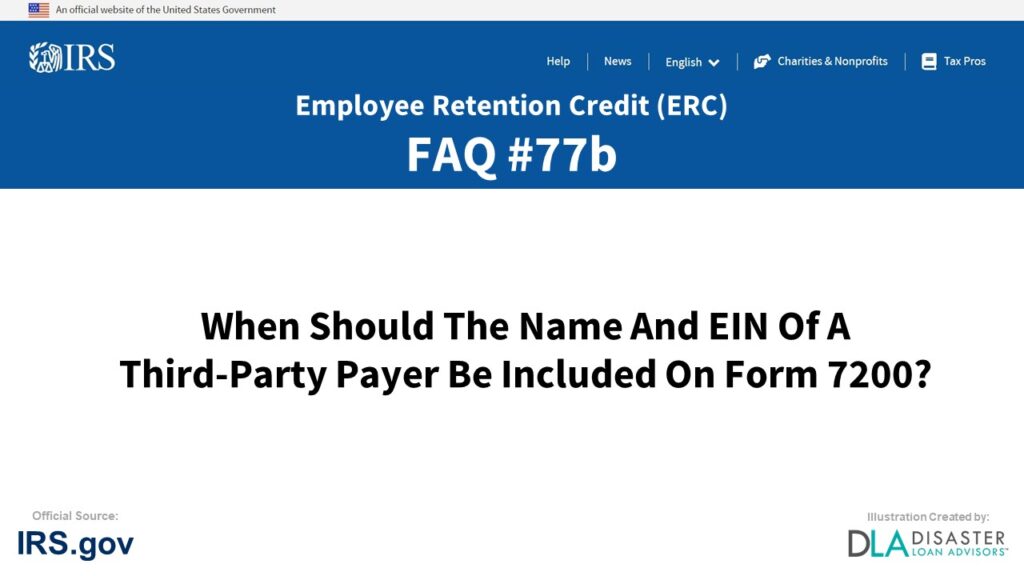
Frequently asked question #77b “When should the name and EIN of a third-party payer be included on Form 7200?” under the How to Claim the Employee Retention Credit section of FAQs: Employee Retention Credit under the CARES Act, provided by the IRS.gov to help business owners understand the ERC program. Information is below for the question #77b When should the name and EIN of a third-party payer be included on Form 7200?
ERC Credit Frequently Asked Question #77b:
COVID-19-Related Employee Retention Credits:
How to Claim the Employee Retention Credit FAQs
77b. When should the name and EIN of a third-party payer be included on Form 7200?
Employers who file Form 7200, Advance Payment of Employer Credits Due to COVID-19, to claim an advance payment of credits are required to include on the form the name and EIN of the third party payer they use to file their employment tax returns (such as the Form 941) if the third party payer uses its own EIN on the employment tax returns.
This will ensure advance payment of the credits received by the common law employer is properly reconciled to the employment tax return filed by the third-party payer for the calendar quarter for which the advance payment of the credits is received.
To help expedite and ensure proper processing of Form 7200 and reconciliation of advance payment of the credits to the employment tax return for the calendar quarter, only those third party payers who will file an employment tax return on behalf of an employer using the third party payer’s name and EIN should be listed on the Form 7200. Typically, CPEOs, PEOs, and other 3504 agents fall into this category of third-party payers.
If a third party payer will file the employment tax return on an employer’s behalf using the employer’s name and EIN and not the name and EIN of the third party payer, the employer should not include the name and EIN of the third party payer on the Form 7200. Typically, reporting agents and payroll service providers fall into this category of third-party payers.
For more Internal Revenue Service (IRS) Department of the Treasury Employee Retention Credit (ERC) How to Claim the Employee Retention Credit FAQs, visit the official IRS.gov tax website.
Conclusion and Summary on ERC Credit FAQ #77b. When should the name and EIN of a third-party payer be included on Form 7200?
The “When should the name and EIN of a third-party payer be included on Form 7200?” is Frequently Asked Question #77b of many commonly asked questions small business owners are wondering about how to file the Employee Retention Tax Credit (ERTC). The IRS ERC Tax Credit program is a confusing and complex process to determine the correct ERC calculations your business qualifies for. Answers to “When should the name and EIN of a third-party payer be included on Form 7200?” and filling out form 941-X may change slightly from frequently updated rules and regulations from the IRS. Leave a comment below if you have further questions on ERC Credit FAQ #77b.
Help Completing / Filing / Claiming the Employee Retention Credit (ERC)
Receive Up to a $26,000 ERC Credit from the IRS Per Employee
Disaster Loan Advisors can assist your business with the complex and confusing Employee Retention Credit (ERC), Form 941-X, and the Employee Retention Tax Credit (ERTC) program.
Depending on eligibility, business owners and companies can receive up to $26,000 per employee based on the number of W2 employees you had on the payroll in 2020 and 2021.
The ERC / ERTC Tax Credit Program is a valuable IRS tax credit you can claim. This is money you have already paid to the IRS in payroll taxes for your W2 employees.
We DO NOT charge a percentage (%) of your ERC Refund like some companies are charging. Some ERC firms out there are charging upwards of 15% to 35% of your ERC refund!
Our professional ERC fee and pricing structure is very reasonable in comparison.
If you are looking for an ERC Company that believes in providing professional ERC Services and value, in exchange for a fair, reasonable, and ethical fee for the amount of work required, Disaster Loan Advisors is a good fit for you.
Schedule Your Free Employee Retention Credit Consultation to see what amount of employee retention tax credit your company qualifies for.
Cover Image Credit: Irs.gov / ERC FAQ / Disaster Loan Advisors.
